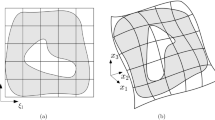Abstract
A stabilized finite element method based on the Nitsche technique for enforcing constraints leads to an efficient computational procedure for embedded interface problems, in which the finite element mesh need not be aligned with the interface geometry. We consider cases in which the jump of a field across the interface is given, as well as cases in which the primary field on the interface is given. Optimal rates of convergence hold. Representative numerical examples demonstrate the effectiveness of the proposed methodology.
Similar content being viewed by others
References
Chessa J, Smolinski P, Belytschko T (2000) The extended finite element method for solidification problems. Int J Numer Methods Eng 28(5): 339–350
Daux C, Moës N, Dolbow J, Sukumar N, Belytschko T (2000) Arbitrary branched and intersecting cracks with the extended finite element method. Int J Numer Methods Eng 48(12): 1741–1760
Dolbow J, Harari I (2009) An efficient finite element method for embedded interface problems. Internat. J Numer Methods Eng 78(2): 229–252. doi:10.1002/nme.2486
Dolbow J, Mosso S, Robbins J, Voth T (2008) Coupling volume-of-fluid based interface reconstructions with the extended finite element method. Comput Methods Appl Mech Eng 197: 439–447
Dolbow JE, Franca L (2008) Residual-free bubbles for embedded Dirichlet problems. Comput Methods Appl Mech Eng 197: 3751–3759
Dolbow JE, Fried E, Ji H (2005) A numerical strategy for investigating the kinetic response of stimulus responsive hydrogels. Comput Methods Appl Mech Eng 194: 4447–4480
Duddu R, Bordas S, Chopp D, Moran B (2008) A combinded extended finite element and level set method for biofilm growth. Int J Numer Methods Eng 74(5): 848–870
Elias R, Martins M, Coutinho A (2007) Simple finite element-based computation of distance functions in unstructured grids. Int J Numer Methods Eng 72(9): 1095–1110
Fedkiw R, Aslam T, Merriman B, Osher S (1999) A non- oscillatory eulerian approach to interfaces in multimaterial flows (the ghost fluid method). J Comput Phys 152(2): 457–492
Fries T (2009) The intrinsic xfem for two-fluid flows. Int J Numer Methods Eng 60: 437–471
Hansbo A, Hansbo P (2002) An unfitted finite element method, based on Nitsche’s method, for elliptic interface problems. Comput Methods Appl Mech Eng 191(47–48): 5537–5552. doi:10.1016/S0045-7825(02)00524-8
Ji H, Dolbow JE (2004) On strategies for enforcing interfacial constraints and evaluating jump conditions with the extended finite element method. Int J Numer Methods Eng 61(14): 2508–2535
Juntunen M, Stenberg R (2009) Nitsche’s method for general boundary conditions. Math Comput 78(267): 1353–1374. doi:10.1090/S0025-5718-08-02183-2
Liu X, Fedkiw R, Kang M (2000) A boundary condition capturing method for Poisson’s equation on irregular domains. J Comput Phys 160: 151–178
Merle R, Dolbow J (2002) Solving thermal and phase change problems with the extended finite element method. Comptu Mech 28(5): 339–350
Moës N, Bechet E, Tourbier M (2006) Imposing essential boundary conditions in the extended finite element method. Int J Numer Methods Eng 67(12): 1641–1669
Moës N, Cloirec M, Cartraud P, Remacle J (2003) A computational approach to handle complex microstructure geometries. Comput Methods Appl Mech Eng 192(3): 3163–3177
Moës N, Dolbow J, Belytschko T (1999) A finite element method for crack growth without remeshing. Int J Numer Methods Eng 46(1): 131–150. doi:10.1002/(SICI)1097-0207(19990910)46:1<131::AID-NME726>3.0.CO;2-J
Mourad H, Dolbow J, Garikipati K (2005) An assumed-gradient finite element method for the level-set equation. Int J Numer Methods Eng 8(8): 1009–1032
Nitsche J (1971) Über ein Variationsprinzip zur Lösung von Dirichlet-Problemen bei Verwendung von Teilräumen, die keinen Randbedingungen unterworfen sind. Abh Math Sem Univ Hamburg 36(1): 9–15. doi:10.1007/BF02995904
Song JH, Areias PMA, Belytschko T (2006) A method for dynamic crack and shear band propagation with phantom nodes. Int J Numer Methods Eng 67(6): 868–868. doi:10.1002/nme.1652
Stenberg R (1995) On some techniques for approximating boundary conditions in the finite element method. J Comput Appl Math 63: 139–148
Tezduyar TE, Behr M, Liou J (1992) A new strategy for finite element computations involving moving boundaries and interfaces—the deforming-spatial-domain/space-time procedure. I. The concept and the preliminary numerical tests. Comput Methods Appl Mech Eng 94(3): 339–351. doi:10.1016/0045-7825(92)90059-S
Valance S, de Borst R, Rethore J, Coret M (2008) A partition-of-unity-based finite element method for level sets. Int J Numer Methods Eng 76(10): 1513–1527
Author information
Authors and Affiliations
Corresponding author
Additional information
AFOSR grant number 09-1-0304.
Rights and permissions
About this article
Cite this article
Harari, I., Dolbow, J. Analysis of an efficient finite element method for embedded interface problems. Comput Mech 46, 205–211 (2010). https://doi.org/10.1007/s00466-009-0457-5
Received:
Accepted:
Published:
Issue Date:
DOI: https://doi.org/10.1007/s00466-009-0457-5




